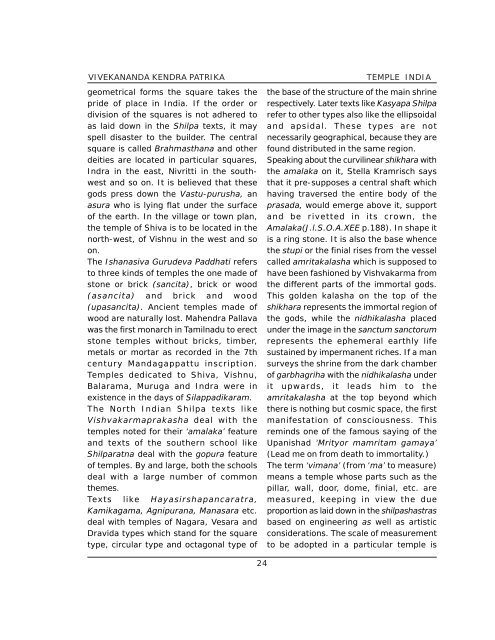Temples In India-1.pdf - Vivekananda Kendra Prakashan
Temples In India-1.pdf - Vivekananda Kendra Prakashan
Temples In India-1.pdf - Vivekananda Kendra Prakashan
Create successful ePaper yourself
Turn your PDF publications into a flip-book with our unique Google optimized e-Paper software.
VIVEKANANDA KENDRA PATRIKAgeometrical forms the square takes thepride of place in <strong>In</strong>dia. If the order ordivision of the squares is not adhered toas laid down in the Shilpa texts, it mayspell disaster to the builder. The centralsquare is called Brahmasthana and otherdeities are located in particular squares,<strong>In</strong>dra in the east, Nivritti in the southwestand so on. It is believed that thesegods press down the Vastu-purusha, anasura who is lying flat under the surfaceof the earth. <strong>In</strong> the village or town plan,the temple of Shiva is to be located in thenorth-west, of Vishnu in the west and soon.The Ishanasiva Gurudeva Paddhati refersto three kinds of temples the one made ofstone or brick (sancita), brick or wood(asancita) and brick and wood(upasancita). Ancient temples made ofwood are naturally lost. Mahendra Pallavawas the first monarch in Tamilnadu to erectstone temples without bricks, timber,metals or mortar as recorded in the 7thcentury Mandagappattu inscription.<strong>Temples</strong> dedicated to Shiva, Vishnu,Balarama, Muruga and <strong>In</strong>dra were inexistence in the days of Silappadikaram.The North <strong>In</strong>dian Shilpa texts likeVishvakarmaprakasha deal with thetemples noted for their ‘amalaka’ featureand texts of the southern school likeShilparatna deal with the gopura featureof temples. By and large, both the schoolsdeal with a large number of commonthemes.Texts like Hayasirshapancaratra,Kamikagama, Agnipurana, Manasara etc.deal with temples of Nagara, Vesara andDravida types which stand for the squaretype, circular type and octagonal type ofTEMPLE INDIAthe base of the structure of the main shrinerespectively. Later texts like Kasyapa Shilparefer to other types also like the ellipsoidaland apsidal. These types are notnecessarily geographical, because they arefound distributed in the same region.Speaking about the curvilinear shikhara withthe amalaka on it, Stella Kramrisch saysthat it pre-supposes a central shaft whichhaving traversed the entire body of theprasada, would emerge above it, supportand be rivetted in its crown, theAmalaka(J.l.S.O.A.XEE p.188). <strong>In</strong> shape itis a ring stone. It is also the base whencethe stupi or the finial rises from the vesselcalled amritakalasha which is supposed tohave been fashioned by Vishvakarma fromthe different parts of the immortal gods.This golden kalasha on the top of theshikhara represents the immortal region ofthe gods, while the nidhikalasha placedunder the image in the sanctum sanctorumrepresents the ephemeral earthly lifesustained by impermanent riches. If a mansurveys the shrine from the dark chamberof garbhagriha with the nidhikalasha underit upwards, it leads him to theamritakalasha at the top beyond whichthere is nothing but cosmic space, the firstmanifestation of consciousness. Thisreminds one of the famous saying of theUpanishad ‘Mrityor mamritam gamaya’(Lead me on from death to immortality.)The term ‘vimana’ (from ‘ma’ to measure)means a temple whose parts such as thepillar, wall, door, dome, finial, etc. aremeasured, keeping in view the dueproportion as laid down in the shilpashastrasbased on engineering as well as artisticconsiderations. The scale of measurementto be adopted in a particular temple is24
















